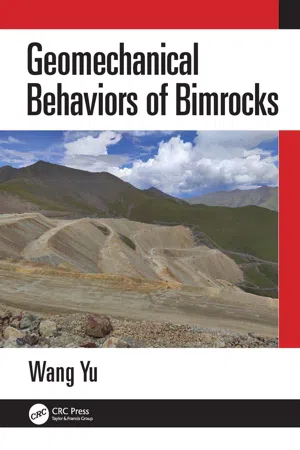
- 406 pages
- English
- ePUB (mobile friendly)
- Available on iOS & Android
Geomechanical Behaviors of Bimrocks
About this book
This book is intended as a reference book for advanced graduate students and research engineers in block-in-matrix rocks (bimrocks) or soil and rock mixtures (SRMs) or rock and soil aggregate (RSA). Bimrocks are complex formations characterized by competent rock inclusions floating in a weaker matrix. Typical types of bimrocks include a series of mixed geological or engineering masses such as mélanges, fault rocks, coarse pyroclastic rocks, breccias, sheared serpentines, and waste dump mixture. Bimrock is especially different from the general soil and rock material, and the detection of the damage and fracture is still wide open to innovative research. Globally, there is a widespread interest in investigating the geomechanical behaviors of bimrocks, such as deformation and strength characteristics, damage and fracture evolution, and stability prediction of bimrock construction. However, the meso-structural factors control the whole mechanical properties of bimrocks; the source of the macroscopic deformation phenomenon is the meso-structural changes. Therefore, evaluation of the mesoscopic physical and mechanical properties, together with advanced testing technique, is an attractive research topic in rock mechanics. As a result, comprehensive macroscopic and mesoscopic experimental investigations should be conducted to reveal the damage and fracturing mechanical behaviors of bimrocks.
The readers of this work can gain new insights into the meso-structural changes of bimrocks subjected to different stress paths. This book is expected to improve the understanding of the mesoscopic damage and fracturing mechanisms of bimrocks, and can be helpful to predict the stability of rock structures where rock mass is subjected to complex loading conditions.
Frequently asked questions
- Essential is ideal for learners and professionals who enjoy exploring a wide range of subjects. Access the Essential Library with 800,000+ trusted titles and best-sellers across business, personal growth, and the humanities. Includes unlimited reading time and Standard Read Aloud voice.
- Complete: Perfect for advanced learners and researchers needing full, unrestricted access. Unlock 1.4M+ books across hundreds of subjects, including academic and specialized titles. The Complete Plan also includes advanced features like Premium Read Aloud and Research Assistant.
Please note we cannot support devices running on iOS 13 and Android 7 or earlier. Learn more about using the app.
Information
Chapter 1
1.1 Mechanical behaviors revealed by variable-angle shear experiments
1.1.1 Introduction
Table of contents
- Cover
- Half Title
- Title Page
- Copyright Page
- Table of Contents
- About the author
- Notations
- Preface
- 1 Macro–meso geomechanical behaviors of bimrocks
- 2 Ultrasonic and mechanical characteristics of bimrocks
- 3 Static fracture evolution of bimrock revealed by in situ CT technique
- 4 Dynamic behavior characterization of bimrocks using the CT technique
- 5 Flow and stress coupled characteristics of bimrock
- 6 Investigation on piping disaster in bimsoils
- Index